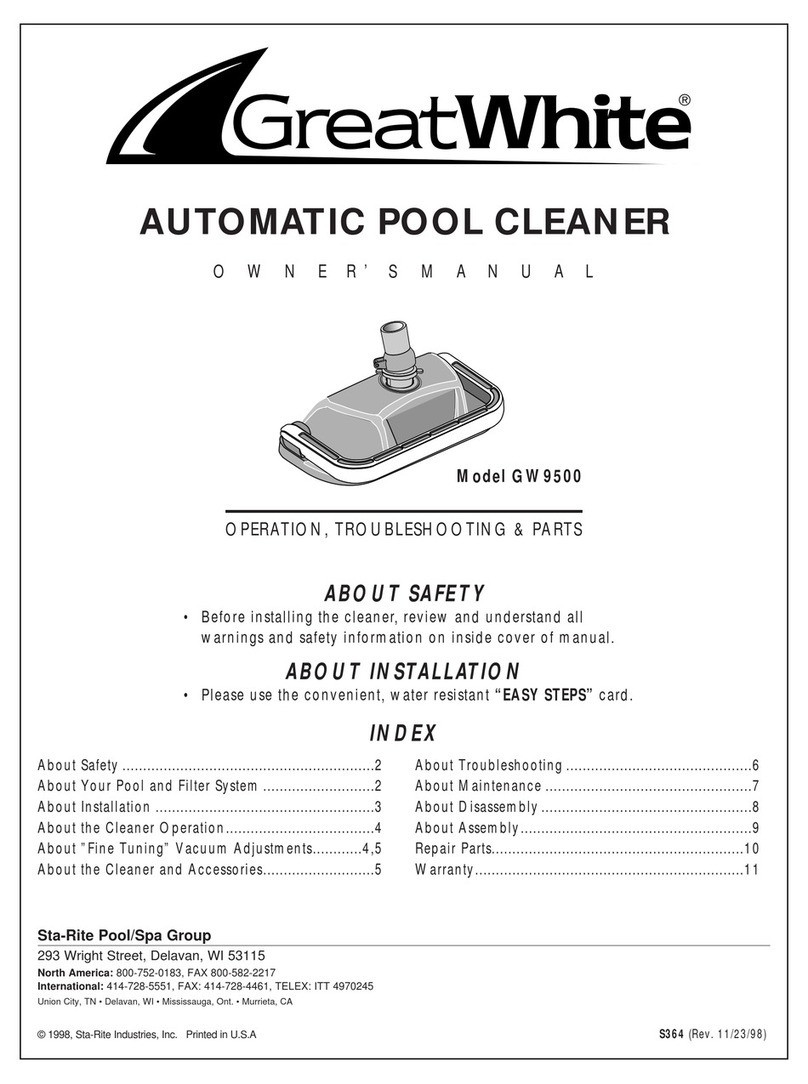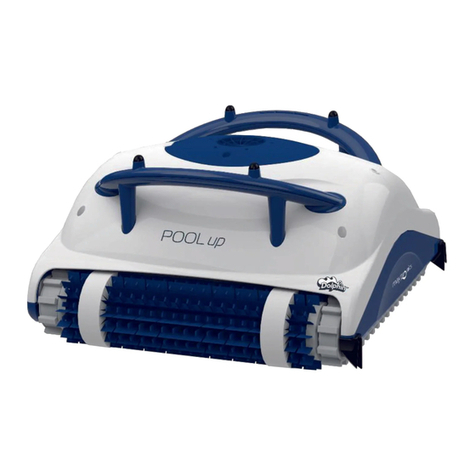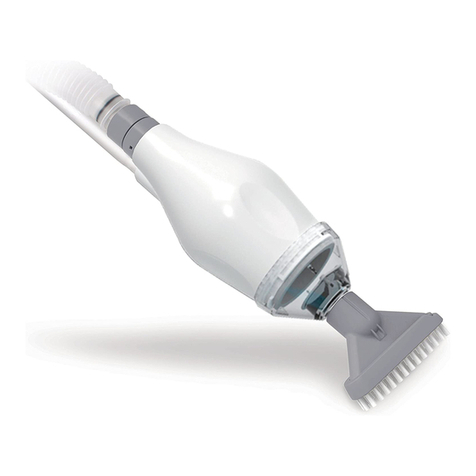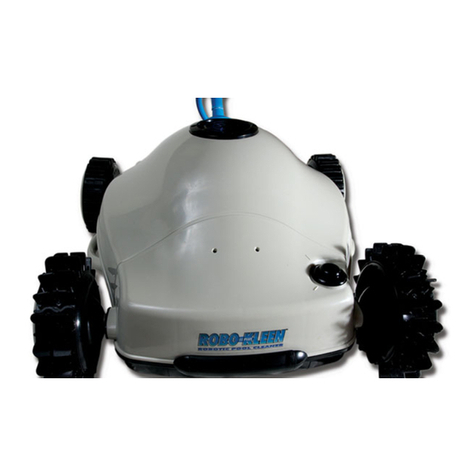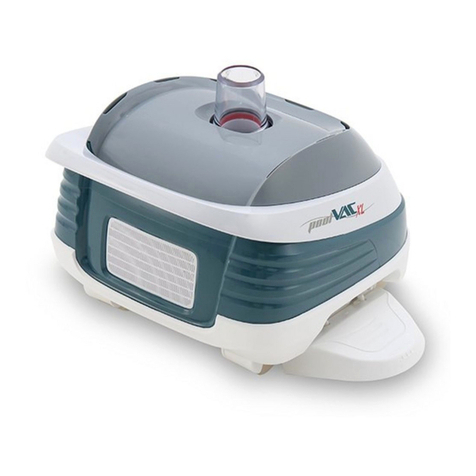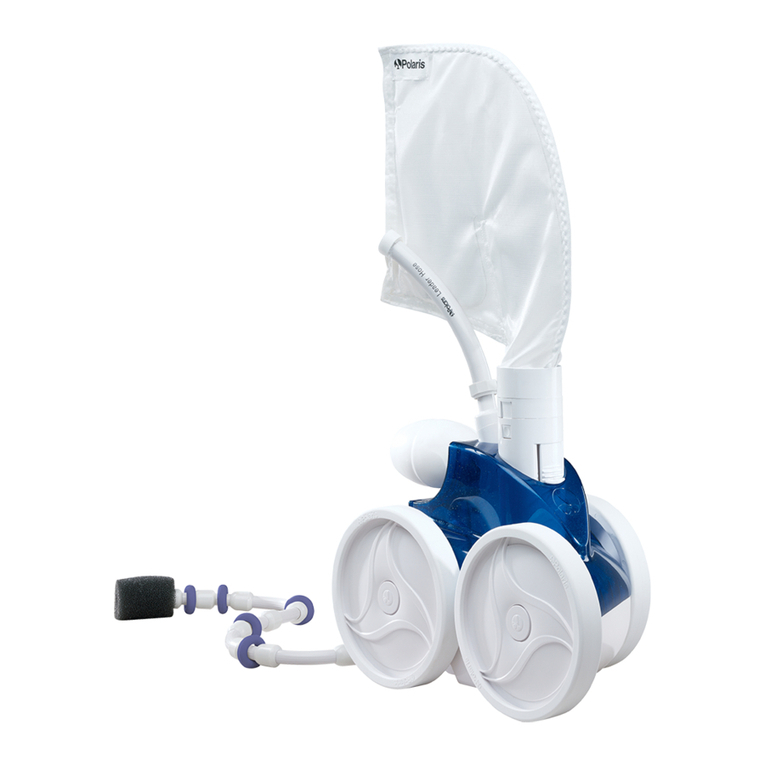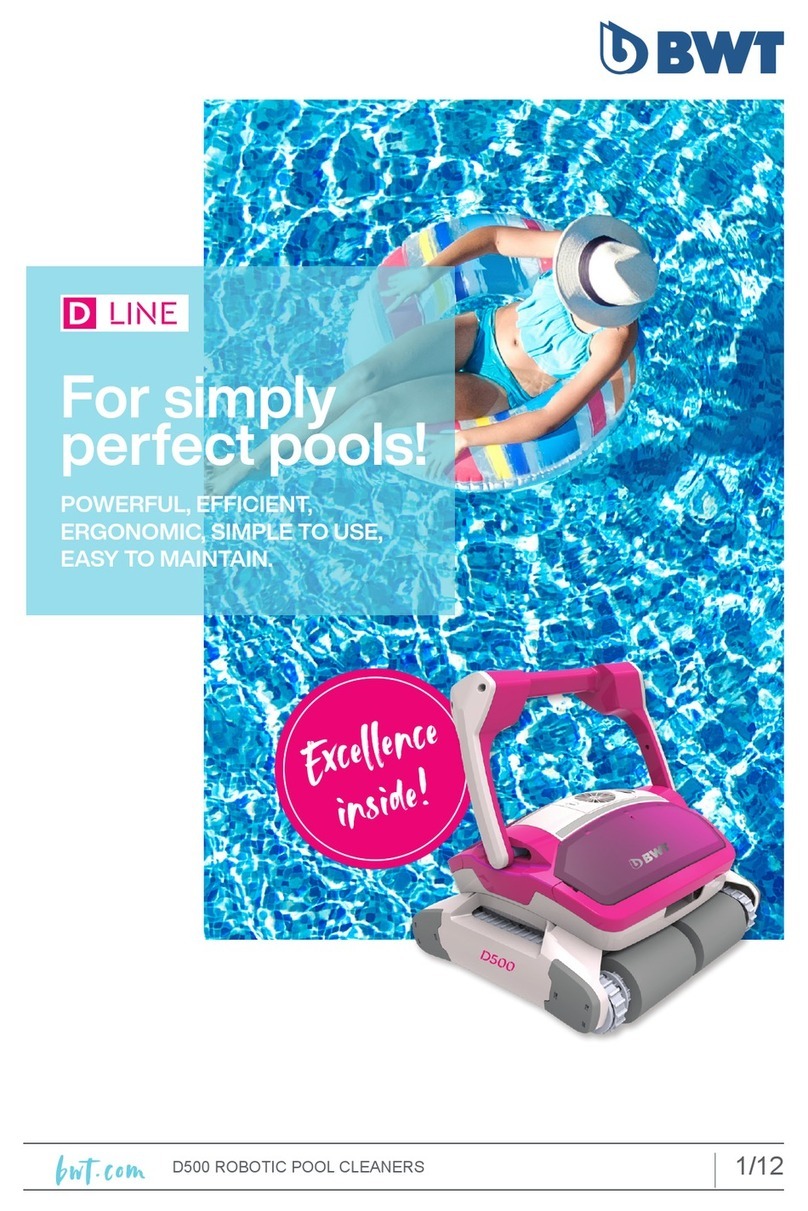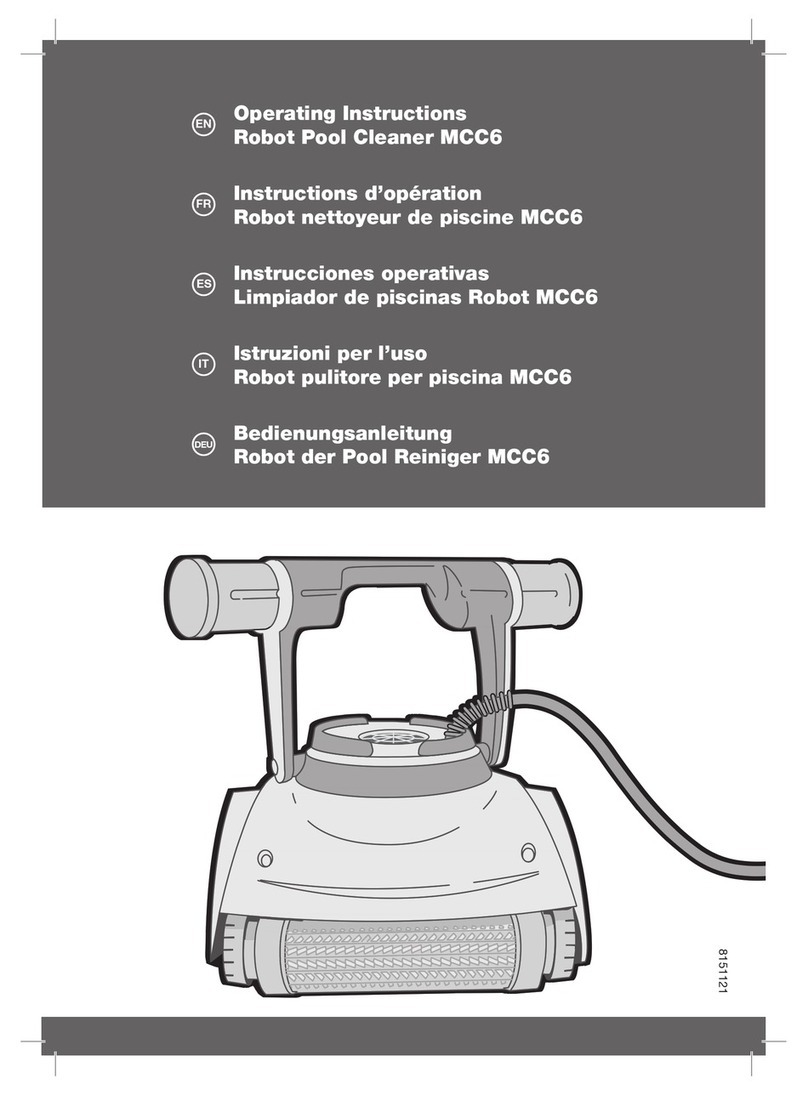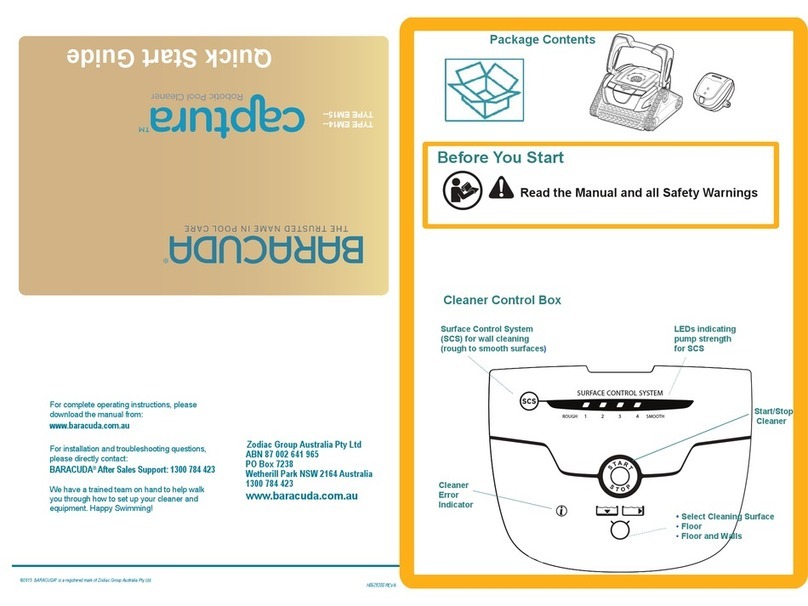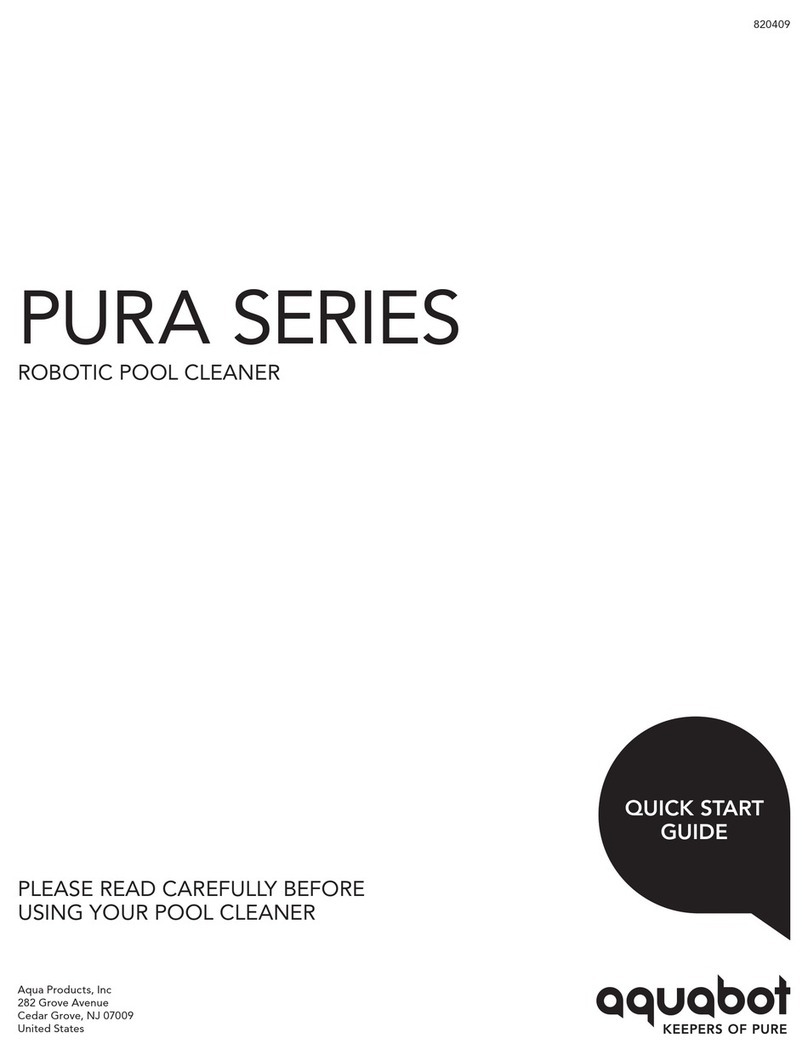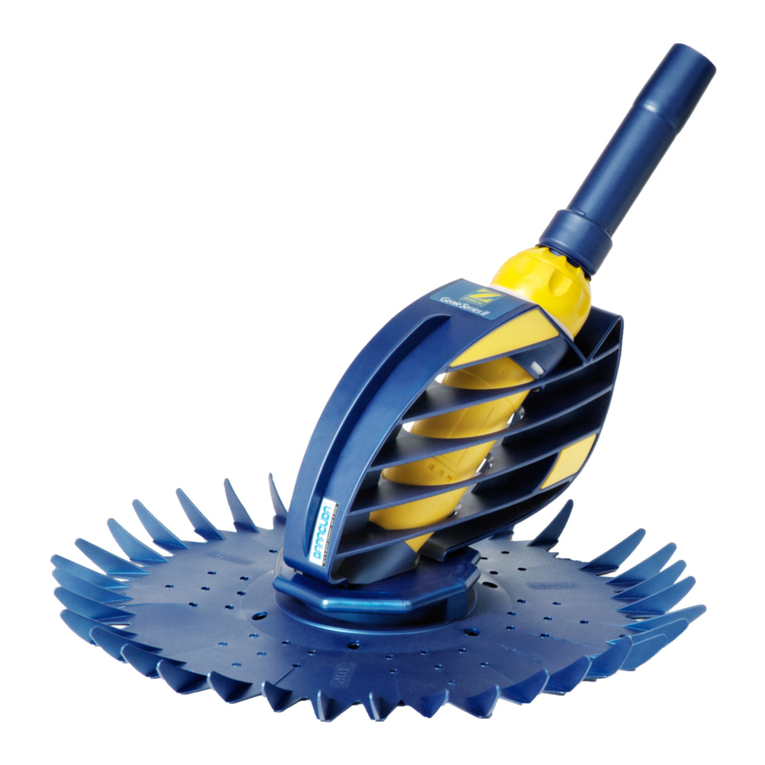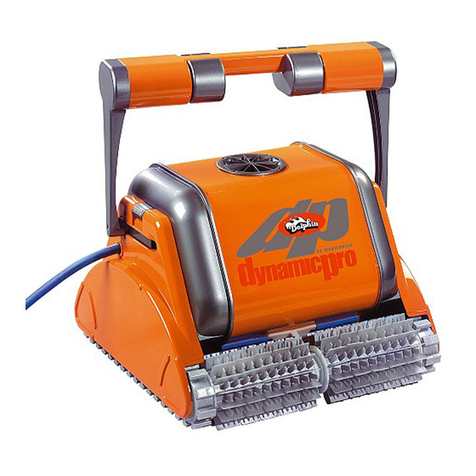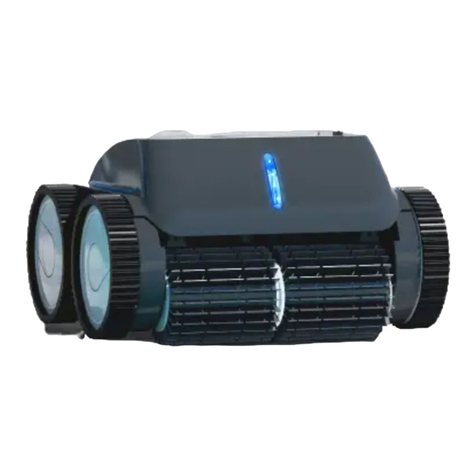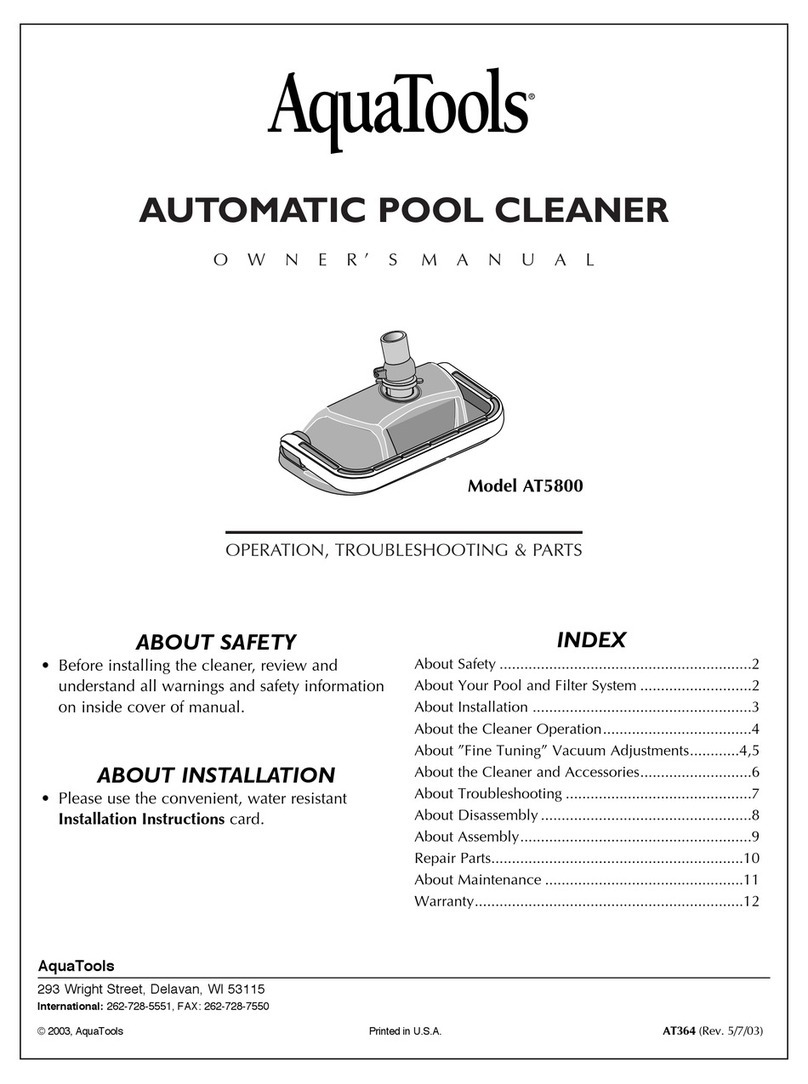Great White GW9500 User manual

AUTOMATIC POOL CLEANER
O W N E R’ S M A N U A L
OPERATION, TROUBLESHOOTING & PARTS
Sta-Rite Pool/Spa Group
293 Wright Street, Delavan, WI 53115
International: 262-728-5551, FAX: 262-728-7550
www.starite.com
Union City, TN • Delavan, WI • Mississauga, Ont. • Murrieta, CA
© 2005, Sta-Rite Industries S789 (4/12/05)
ABOUT SAFETY
• Before installing the cleaner, review and understand all
warnings and safety information on inside cover of manual.
ABOUT INSTALLATION
• Please use the convenient, water resistant “EASY STEPS” card.
About Safety .............................................................2
About Your Pool and Filter System ...........................2
About Installation .................................................3, 4
About the Cleaner Operation....................................5
About ”Fine Tuning” Vacuum Adjustments...............6
About the Cleaner and Accessories...........................7
About Troubleshooting .............................................8
About Disassembly ...................................................9
About Assembly......................................................10
Repair Parts.............................................................11
About Maintenance ................................................12
Warranty.................................................................13
INDEX
1873 0795
Model GW9500

2
Before installing your cleaner, review and
understand all warnings and safety informa-
tion on the inside front cover of this manual.
Pre-installation check list
Before installing the cleaner in a vinyl liner pool:
Check liner closely for signs of deterioration or damage
from age, chemicals, pool wall damage, etc. If any damage
is found, have a qualified pool professional make all neces-
sary repairs. Also, if there are stones, roots, etc., under the
liner, remove them before installing the cleaner.
Before installing the cleaner in a gunite pool or a pool
that is partially or completely tiled:
Repair loose tiles and tighten any loose light rings.
Before installing the cleaner, clean your filter system:
Make sure you have cleaned the filter, including back-
washing, rinsing, and emptying all baskets. A clean system
is necessary for proper cleaner operation and coverage.
Before installing the cleaner, fill the hose with water:
Always make sure the cleaner head is submerged and
the hose is full of water before connecting the hose to
the filtration system (whether through a skimmer or dedi-
cated wall fitting). Air in the system can damage the
pump through dry running and overheating.
Before installing the cleaner, understand cleaner
coverage:
The cleaner is designed to rid your pool of debris in
approximately 4-6 hours. Less time could be needed,
depending on the pool size.
The cleaner was not designed to automatically clean
steps or swimouts or to work under a solar cover. It was
also not designed to do initial cleanup for a new pool or
when opening your pool for the season.
Suction entrapment, injury, and drown-
ing hazard. If your pool has a dedicated suction
port (“vac port”) for vacuuming or for an automatic
pool cleaner, it must be covered when not in use.
A spring loaded safety cover is included with your
cleaner. Install it on the suction port to prevent
entrapment and injury.
ABOUT YOUR POOL AND FILTER SYSTEM:
This is the safety alert symbol. When you see this
symbol on your system or in this manual, look for
one of the following signal words and be alert to the
potential for personal injury.
warns about hazards that will cause
death, serious personal injury, or major property dam-
age if ignored.
warns about hazards that can cause
death, serious personal injury, or major property dam-
age if ignored.
warns about hazards that will or can
cause minor personal injury or property damage if
ignored.
Carefully read and follow all safety instructions in this
manual and on equipment. Keep safety labels in good
condition; replace if missing or damaged.
Hazardous suction.
Can trap and tear
hair or body parts.
Can cause drowning.
Do not play with cleaner
or hose or apply to body.
Do not let children use or
play with pool cleaner.
Stop pump before
attempting to clean unit.
1058 0594
Oscillator may
injure hands or fingers.
Stop pump before attempt-
ing to clean out pool cleaner
head.
Hose can trip
or entangle swimmers.
Do not allow swimmers in
pool while pool cleaner is
operating.
Please read the following before installing
your new automatic pool cleaner!
ABOUT SAFETY:

3
ABOUT INSTALLATION
Please use the convenient, water resistant,
“EASY-STEPS”
card.
Step 1: Install vacuum port door fitting
If there is no spring-loaded door on the vacuum port,
install the included cover.
If you pool only has a skimmer, and no dedicated vacu-
um port, proceed to Step 2.
1. Screw the fitting into the port opening.
2. Orient the fitting so the arrow on the door points up.
3. Secure the cover by tightening the allen-screw below the
door.
Step 2: Straighten hose (Figure 2)
Remove and uncoil the hose from the carton. Lay it out
in the sunlight, flat and straight.
Step 3: Check parts (Figure 3)
• Cleaner assembly
• Black plastic swivel assembly
• Handle adapter
• White rubber reducer cone
• Hoses: 20’, 8’ and 4’
• White plastic vacuum regulator
• Cap for regulator
• Vacuum port fitting
• Flow gauge
Step 4: Clean filter system (Figure 4)
Backwash and clean filter; rinse; clean all baskets, etc.
Start pump.
Step 5: Adjust valves for vacuuming (Figure 5)
Decide on the vacuum connection you are going to use
(either a skimmer or a dedicated wall fitting) and adjust
the pump valves (if your system has valves) to direct all
vacuum there.
Close the main drain (also see “About Fine Tuning the
Vacuum”, Page 6).
1882 0795
Figure 2
Figure 1
Regulator Regulator
Cap
Swivel
Ass'y Reducer
Cone
Vacuum
Port
Flow
Gauge
Hose
Handle
Cleaner
1902 0795
8'
20'
4'
M
A
X
I
M
U
M
F
L
O
W
M
I
N
I
M
U
M
F
L
O
W
1880 0795
Skimmer
Vac
Port
Figure 3
Figure 4
Figure 5

4
Step 6: Assemble cleaner (Figure 6)
Insert swivel assembly into cleaner; twist 1/4 turn.
Step 7: Measure hose length needed (Figure 7)
Before connecting the hose, lay it out from the vacuum
connection you are using (whether skimmer or dedicated
wall fitting) to the furthest point of the pool. The hose
should be at least 4’ longer than this. More than 4’
longer is OK.
Do not cut the hose.
Fill the hose with
water and keep the ends accessible.
Step 8: Install Regulator
Install the regulator and reducer cone in the skimmer.
Refer to illustrations A and B on the following page.
Attach the end of the hose to the regulator (Figure 8), or
to the vacuum port (Figure 9) depending upon your pool.
Step 9: Check Flow
Close the main drain and insert one end of the hose into
the vacuum source (skimmer or vacuum port: see
below). Insert the flow gauge into the other end of the
hose, Keep the hose and flow gauge underwater. Turn on
the pump.
With the pump running, adjust the regulator until the
indicator on the flow gauge is between minimum and
maximum flow.
Remove the flow gauge and attach the hose to the cleaner.
Step 10: Connect Hose to Cleaner
Connect the hose cuff of the 20’ hose to the swivel
assembly in cleaner (correct end of hose is marked). Fill
the cleaner with water and let it sink to the bottom.
Verify hose connections as shown below, and that gate
valves are fully open in the suction line.
INSTALLATION
Skimmer
Regulator
To Pump
Adapter Cone
Figure 9: Regulator
installed with cap.
Skimmer
Regulator
Cap
To Pump
Adapter Cone
Figure 8: Regulator
installed with hose
connection.
Figure 11
Hose Cuff
marked
"Connect
to Cleaner"
1875 0795
Figure 12
Hose must equal longest stretch — — plus at least 4 feet.
Figure 7
Swivel
Assembly
Figure 6
Figure 10
Disc Indicator

5
Clicking sound
This sound is the oscillator moving back and forth in the
oscillator chamber. The best speed for it is about 500
oscillations per minute. The vibration created by the
oscillator moves the bristles and the cleaner. If the oscil-
lator is running too fast, the cleaner will have a tendency
to climb up the pool wall past the waterline, or “walk
out of the pool”.
Movement around the pool
Random motion – The cleaner will visit most spots in the
pool in a 6 hour period. It is not specifically programmed
and cannot see the dirt you are seeing. It is a random
motion cleaner.
The cleaner was designed to spend most of its time in
the deep end, where most of the floor and wall area
exists. During a 6 hour period the cleaner will visit the
shallow end a few times.
Rotating motion – The cleaner will rise up on one side
and pivot a few times per minute. This is normal and
provides the following:
1. Allows leaves that are being pushed or dragged along to
be sucked up into the vacuum chamber.
2. Allows the cleaner to:
Change direction
Get out of corners
Get away from ladders
Submerge below pool water level
Get off of domed main drain covers
Picks up big “stuff”
The cleaner will pick up some debris so large that it may
jam. Simply stop the pump and remove the debris from
the oscillator or the swivel assembly.
ABOUT THE CLEANER OPERATION:
HOSE CONNECTIONS:
Follow drawing that most closely resembles your skimmer installation.
Reducer
Cone
Vacuum
Regulator
Water
Level
Skimmer
Port
Gate valve for
skimmer must
be fully open
Water
Level
Reducer
Cone
Vacuum
Regulator
with Cap
Skimmer
Gate valve for
vacuum port must
be fully open
B
A

6
Pool pump suction is hazardous and
can cause entrapment with severe personal injury or
drowning. Use vacuum regulator (see instructions below)
in pool cleaner system at all times.
Note: Each pool’s hydraulic system and vacuum connec-
tions are different. Be sure you have installed the white
plastic vacuum regulator before you “fine-tune” the sys-
tem. This not only regulates vacuum, but also acts as a
safety device.
Suction entrapment, injury, and drown-
ing hazard. If your pool has a dedicated suction port
(“vac port”) for vacuuming or for an automatic pool
cleaner, it must be covered when not in use. A spring
loaded safety cover (the “Vac Port Fitting”) is included
with this pool cleaner. Install it on the suction port to pre-
vent entrapment and injury. For details please refer to the
Vac Port instruction sheet included with your Vac Port.
For the
“NOVICE POOL OWNER”
where vacuuming is a
new experience, please read all of the following points,
installation instructions, and trouble shooting guide carefully.
Please note the following:
• “
Vacuum
” and “
suction
” are two words meaning the same
thing.
• “
Dedicated suction line
”, “
vac port
”, and “
vac fitting
” are
different terms for a hole in the side wall of pool; this hole
is connected to the pump suction and is dedicated to
vacuuming.
• Some pools do not have a vac port. If your pool does have
one, please read the “Suction Entrapment” warning above.
For the
“SEASONED POOL OWNER”
: The automatic pool
cleaner connection and vacuum adjustments can be similar
to using your manual pool vacuum. Please read on.
Valves (pump, skimmer, and main drain)
and vacuum adjustments
You may need to spend some time adjusting the skimmer
and main drain valves in order to obtain the best vacuum
setting for good cleaner operation. Once you have found
the correct valve settings for best operation, we suggest you
mark the valves to ensure repeated success.
At first, set valves to give maximum vacuum to the skim-
mer or vac fitting you have elected to use.
Too much vacuum?
You have too much vacuum if the cleaner climbs up the pool
wall past the water line to the point that the cleaner sucks air
and the pump loses prime. Frequent loss of prime will dam-
age the pump. To correct this, adjust the regulator by turning
the adjustment know counter-clockwise. This will decrease
the suction. If the cleaner still climbs out and sucks air, open
the main drain valve slightly.
Not enough vacuum ?
You don’t have enough vacuum if the cleaner moves slug-
gishly or not at all. Be sure the filter system is clean and the
regulator and all valves are adjusted to give you maximum
vacuum. If the cleaner is still not moving, your pump may
not be strong enough to operate the cleaner. Also, please
refer to the Troubleshooting guide on Page 8.
In-Line leaf canisters
If your pool is exposed to large quantities of leaves, we sug-
gest purchasing and installing an in-line leaf canister. A leaf
canister will provide more debris-loading capacity and also
provides a water by-pass when the canister is full. It is very
important that the pump not starve for water!
Dedicated suction line/vac port/vac fitting
Some pools have a dedicated wall fitting just for vacuum-
ing. If the wall fitting connection is used, you may notice
that the clear pump lid shows signs of bubbles or what
appears to be the presence of air. To eliminate this, slightly
open the main drain valve to supplement the water intake.
The cleaner may slow down a bit when you change the
suction.
Skimmer connection
Some pool owners remove the skimmer basket and con-
nect the hose directly into the bottom of the skimmer. This
method is OK for pools with minimal debris
and also for screened in pools.
For pools that have large quantities of “big stuff” to pick up,
we suggest using the bottom of the skimmer connection in
conjunction with an in-line leaf canister (purchase the can-
nister locally). A leaf canister will provide more debris-
loading capacity and also provides a water by-pass when
the canister is full.
It is very important that the pump not
starve for water!
Skimmer vac plates
Some pool owners connect the hose to a skimmer vac
plate, which allows the skimmer basket to remain in the
skimmer. If this method is used, empty the basket frequent-
ly. Also make sure that the vacuum regulator provided is
completely submerged so that it will not suck air and dam-
age the pump.
Skimmer vac plate vacuum
control adjusters
Some pool owners use one of a variety of manufacturer’s
skimmer vac plates. Some have a vacuum control adjuster,
and some do not. The adjuster could be a screw-type, a
spring loaded apparatus, or a dial design. For those vac
plates with adjusters, it is important to adjust them when
fine tuning the vacuum for the cleaner.
ABOUT “FINE-TUNING” VACUUM ADJUSTMENTS AND CONNECTIONS:
If you have any questions, please call 1-800-752-0183

7
ABOUT THE CLEANER AND ACCESSORIES:
Swivel assembly (Figure 13)
Installing the swivel assembly is a snap.
Just insert it into the cleaner body and
give it a quarter turn.
If you attach a unidapt handle to the
swivel for manual vacuuming, be sure it
is the special, floating unidapt handle
provided with the cleaner (Replacement
Part No. GW9019). Use of a different
unidapt handle will hinder the cleaner’s performance.
Hoses (20’, 8’ and 4’ lengths – Figure 14)
The unit includes a 20’ hose, an 8’
hose, and a 4’ hose. Do not cut any of
these hoses.
The best hose length is at least 4’
longer than the distance from your suc-
tion source (whether skimmer or dedi-
cated suction line) to the furthest point
in the pool. If the hose seems to be too
long, remove the 8’ section provided.
Do not cut the 20’ hose.
Be sure to connect the tapered end of
the 20’ hose (marked “connect to
cleaner”) to the cleaner head.
If additional hose is needed, use only
the specially designed 8’ extension hose from your
Sta-Rite dealer (order replacement part No. GW9511).
Use of another manufacturer’s hose will hinder cleaner
coverage (this also holds true for the 20’ hose). If you
need to replace the 20’ hose, buy only the original
equipment hose (order replacement part No. GW9521).
Flow gauge (Figure 15)
Insert the flow gauge into the
hose end. With the pump run-
ning, adjust the regulator until
the indicator on the flow gauge
is between maximum and mini-
mum flow.
Reducer cone (Figure 16)
The reducer cone is required to make
most hose connections. When used, it will
keep the hose in place if the filter system
is stopped.
Automatic vacuum regulator (Figure 17)
Hazardous suction. Can cause entrap-
ment with severe personal injury or drowning.
Vacuum regulator should be installed in
all situations. The vacuum regulator has
an adjustment knob. If suction is too high,
the knob is turned counter-clockwise to
decrease the suction. If the suction is too
low, then the knob is turned clock-wise to
increase the suction.
The regulator is installed in the skimmer.
The hose will connect to the dedicated vacuum port, or
to the top of the regulator if the pool lacks a suction port.
The regulator must be capped if a hose is not connected
to it.
Make sure the vacuum regulator is submerged at all
times. If not, the pump will suck air through the regulator
and lose prime.
This could damage the pump.
Vac port fitting (Figure 18)
Suction entrapment, injury, and drown-
ing hazard. If your pool has a dedicated suction
port (“vac port”) for vacuuming or for an automatic
pool cleaner, it must be covered when not in use.
A spring loaded safety cover (the
“Vac Port Fitting”) is included with
this pool cleaner. Install it on the
suction port to prevent entrapment
and injury. For details please refer
to the Vac Port instruction sheet
included with your Vac Port.
1883 0795
20'
8'
4'
Figure 13
Figure 14
Figure 16
Cap
Adjustment
Knob
Figure 17
Vac
Port
Figure 18
ABOUT BUMPER INSERTS
Bumper Inserts (see Key 2A, Page 11) help to make the
cleaner more buoyant to allow better access to the shal-
low end of the pool. Do not install inserts from the top;
they will become jammed and not work properly. Only
install inserts from the bottom.
If the bumper on the cleaner appears to lift the cleaner
to the surface of the pool, check for trapped air in the
cleaner and hose. If no air is found, remove one
bumper insert block and watch and see if the cleaner
remains submerged and on the pool floor while work-
ing. If not, remove individual insert blocks as needed
until the cleaner rests on the pool floor and operates
properly.
Disc Indicator
Figure 15

8
SOLUTIONS:
1. Backwash and/or clean filter. Empty all baskets. This should help your cleaner attain the desired
oscillation rate of 400-600 times per minute.
2. Clear all debris from oscillator chamber, hose, or vac plate by-pass (if you have one).
3. Repair all sources of vacuum leaks (cracked vac plate, vac plate or reducer cone not seated prop-
erly, cracked hose, vac regulator adjusted too loosely).
4. Adjust valves to give maximum vacuum to the vacuum port or skimmer to which you are attach-
ing the cleaner hose. Reduce or shut off other skimmers and main (floor) drain.
Note: Each pool’s hydraulic system is different. It may require some adjustments to skimmer and
main valves before you achieve the vacuum setting required for the best cleaner to operation.
Once determined, mark the valves at that position to ensure repeated success.
5. Filtration system (pump) does not develop enough vacuum. Consult your pool service
professional.
6. In hot water, the hose may kink. The hose, when old, may have developed leaks
(cracks or holes) or may get brittle. Purchase a new hose.
NOTE: It must be a Sta-Rite hose for proper operation.
1. Oscillator is running too fast. Make sure vacuum regulator is installed and adjusted.
2. If step 1 does not solve the problem, slightly open the main drain valve until the cleaner no
longer climbs out of the pool.
1. A clean filter system will help the cleaner to move much faster. Also, be sure to clean all baskets.
2. Vinyl liner pools with a deep end hopper will require 6-8 hours to clean. In this time the
cleaner should make at least 4 trips to the shallow end. If not, call Customer Service at
1-800-752-0183.
3. Examine the lift brush mechanism as the cleaner is operating. To do this, you will have to turn
the cleaner over while it is running and submerged. If the lift brush does not move to the “down”
position within 2 minutes, call Customer Service at 1-800-752-0183.
4. The cleaner was not designed to work under solar covers. If you have a solar cover, only minimal
coverage can be expected.
5. At times strong winds may hinder cleaner coverage!
6. Any cleaner might miss a spot. Your cleaner has been designed to accommodate the attachment
of a vac-pole (telepole) by use of the handle in the accessory bag. Attach pole for spot cleanups,
steps, and swimouts.
1. Examine the lift brush mechanism as the cleaner is operating. To do this, you will have to turn
the cleaner over while it is running and submerged. If the lift brush does not move to the “down”
position within 2 minutes or less, call Customer Service at 1-800-752-0183.
1. This cleaner was not designed to clean these areas. Use the handy telepole attachment, connect
the pole, and clean missed areas.
1. This is normal with some filter systems that develop a surge of back pressure when the system
shuts off. The cleaner will right itself when the system is restarted.
1. Use reducer cone when connecting to the skimmer or vac port.
1. Hose might be too short. Desired length can be measured from the point where the hose is con-
nected, to the furthest point of the pool, plus a minimum of an additional 4’. If needed, purchase
an extension hose from your local dealer. Do not cut extension hose – use it full length even if it
is a little long.
1. For best results, when hose is not in use, store it uncoiled, flat, and straight. If coiling is
necessary, coil loosely.
2. Lay hose out flat and straight in the sunlight for a few hours prior to use.
ABOUT TROUBLESHOOTING
SITUATION
Cleaner does not move.
Oscillator is very slow.
Cleaner climbs past water
line of pool causing pump to
lose prime (suck air).
Cleaner coverage not as
expected.
Cleaner “stuck” in one spot
(more than 15
minutes).
Steps and “swim-outs” are
not clean.
Cleaner flips on its back
when pump stops.
Hose comes loose when
pump stops.
Cleaner hovers in one area
with hose fully extended.
Hose keeps coiling up.
If you have any questions, please call 1-800-752-0183

9
If you have any questions, please call 1-800-752-0183
1. Remove swivel assembly (Figure 19) from the top of the
cleaner by turning it 1/4-turn counterclockwise and
pulling straight up on it.
2. Turn cleaner upside down. Remove 4 screws and
remove lower body assembly from shroud.
3 . Turn lower body assembly right side up. Unsnap the 2
clips on the oscillator chamber cap (Figure 20A); lift it
off.
4. Pull the long gear shaft straight up (Figure 20A) by the
blocks on the ends of the shaft. Hold the seals in the
oscillator and the blocks on the shaft. The cam may
interfere with the shaft mounting post; if so, turn it
slightly on the shaft until it clears the post. The shaft
assembly can now be disassembled (Figure 20B).
5. Slide the long gear shaft out of the oscillator (with
gears, complete); make sure that you don’t lose the
seals out of the oscillator which may fall out at this
point (Figure 20B).
5A. Oscillator seals are replaceable.
5B. Ratchet gear set and long shaft are replaceable as a
unit.
6. Remove the set screw, short gear shaft, and gears
(Figure 21); be sure to keep the gears on.
7. With a small screwdriver (such as a jeweler’s screwdriv-
er), a pencil, or a pen point, depress and remove the coil
spring from the lift brush mounting post (Figure 22).
Replace the brush and the spring if necessary.
8. The metal ratchet tab slides out of its slot sideways;
replace it by removing the center brushes and sliding in
a new ratchet tab until it is flush with the edge of plas-
tic holder (Figures 23 and 24). Replace the center
brushes.
9. The brush ring pops out of the cleaner body for easy
replacement.
10. If you need to replace the bumper, turn the shroud and
bumper assembly upside down and remove the two
screws holding the bumper to the shroud.
1889 0795
Clip
Ocillator
Chamber
Cap
Block
Long Gear Shaft
Block
Cam
Locked Twist CCW
1/4 Turn
Pull Straight
Up
"Click" at
this point
Swivel
assembly
3337 1098
4374 0503
1887 0795
1886 0795
1. Slide metal ratchet tab
toward end of cleaner body
1885 0795
2. Slide metal ratchet tab
down through cleaner body
1884 0795
Figure 20A Figure 20B
Figure 19
Figure 21 Figure 22
Figure 23 Figure 24
ABOUT DISASSEMBLY

10
ABOUT ASSEMBLY
If you have any questions, please call 1-800-752-0183
1. Put both white seals in the oscillator; hold them in place.
2. Install the oscillator on the long gear shaft. Install the
ratchet gear on the shaft so that the teeth engage the
ratchet on the oscillator. Install the spring, ratchet drum,
pinion gear (large gear first), and cam (gear end first) on
the shaft (See Figure 25). Hold the gears on the shaft
while installing them, and compress the clutch spring to
allow assembly to slip into place between the posts (See
Figure 25).
3. Install the long gear shaft and end blocks in the cleaning
head with the large arm of the cam down (see Figure
26).
4. Reinstall the short gear shaft, set screw and two gears
(See Figure 27); the small pinion gears and the shaft set
screw go on the side toward the
end
of the cleaner –
away from the oscillator box. Make sure that the gears
engage the gears on the long gear shaft.
5. Install the oscillator chamber cap and clip it in place.
6. Install the rubber vacuum skirt on the cleaner with the
word ‘OUTSIDE’ showing. Start at the large pin on the
back of the cleaner head (see Figure 28) and work
around the cleaner. Make sure the skirt is flush against
the stop strips on the cleaner head (see Figure 29).
7. Turn the cleaner over. If you removed the bumper and
brush ring, replace them now.
8. Install the lower body assembly in the shroud. Fasten the
cleaning head in place with 4 screws (2 long, 2 short –
see Figure 30).
NOTE: Make sure that you do not dislodge the rubber
vac skirt while inserting the lower body assembly past
the brush ring.
1894 0795
Seals
Figure 25
Swing Cam
Arm up for
Clearance
Make sure Oscillator
is partially inserted in
chamber while reinstalling
Shaft Assembly
Oscillator
Chamber
Figure 26
Figure 27
Start here with
large button when
installing vacuum skirt.
OUTSIDE
'Outside' will show
(facing out) when
skirt is correctly installed. Rubber
vacuum skirt
1893 0795
Figure 28
This
Not
This
1892 0795
Figure 29
#10-16x1" Screws
#10-16x1-3/4" Screws
Center
Brush
Location
Lift Brush
Location
Center
Brush
Location
Bottom View of Cleaner
1891 0795
Figure 30

REPAIR PARTS
Key Part Part
No. Description No.
1 Swivel Assembly GW9012
2 Bumper GW9502
2A Bumper Insert Kit (Set of 4) GW9520
3 Screw Kit (4 short, 2 long) GW9504
4 Shroud GW9501
5 Brush Ring GW9505
6 Oscillator Chamber Cap GW9506
7 Cam Kit (2 & 3 Leg Cams) GW9507
8 Idler Gear Kit (Incl. 3 Gears) GW9509
9 Block Kit (Incl. 2 Blocks) GW9512
10 Long Gear Shaft (Stainless Steel) GW9513
11 Set Screw #4 Self Tapping##
11A Shaft Kit, Stainless Steel (includes Set Screw) GW9536
12 Lower Body* GW9535
13 Lift Brush GW9517
14 Vacuum Skirt GW9508
15 Lift Brush Spring GW9522
16 Ratchet Tab (Stainless Steel) GW9523
17 Oscillator Seal Kit (Incl. 2 Seals) GW9004
18 Oscillator Assembly Kit (Incl. Key #17) GW9503
(Ratchet Assembly not sold separately)
19 Center Brush Kit (Set of 2) GW9013
• 4’ Vacuum Hose Extension (1/pkg.) GW9519
• 20’ Vacuum Hose (1/pkg.) GW9521
• 8’ Vacuum Hose Extension (1/pkg.) GW9511
• Replacement Hose Kit
(1 each 20’, 8’ and 4’ Hose) GW9516
• Vacuum Regulator 41200-0200
• Vacuum Regulator Cap 41200-0211
• Reducer Cone GW9015
• Unidapt Handle GW9019
• 4" Short Extension Hose GW9021
• Vac Port Fitting GW9530
• Flow gauge 41200-0210
• Not illustrated.
* Includes Key Nos. 6, 11A, 13, 15, 16, two idler gears
and 2-arm cam.
## Not available separately.
Optional Accessories
Vacpole
R
1897 0795
If you have any questions, please call 1-800-752-0183
1
2
2A
3
3
4
5
6
7
8
8
9
3
3
3
10
11
12
11A
13
14
15
9
19
18
17
16
1896 0795
11

12
ABOUT MAINTENANCE AND CARE
Hazardous suction. Stop pump before
attempting to clean pool cleaner.
• Keep skimmer basket and pump strainer basket clean
and free of debris.
• If cleaner jams with large debris (leaves, sticks, etc.), try
cleaning debris first from bottom of unit. If this doesn’t
clear unit, remove top swivel assembly (turn 1/4 turn)
and clear the debris from the top.
• Remove the pool cleaner from the pool before super
chlorinating (shocking) or chemical balancing. Wait at
least four hours after the chemical procedure before
reinstalling the cleaner.
• Make sure that the cleaner’s brush bristles don’t
become deformed during storage. Store the unit so that
it doesn’t sit on the bristles and so that nothing com-
presses them.
• If possible, do not coil the hose. Remove the hose from
the cleaner when removing the cleaner from the pool.
Store the hose flat and straight.
• Periodically examine bristles and vacuum skirt for wear
or distortion. Replace if necessary. See "Assembly",
Page 10.
• If necessary to remove oscillator, see "Disassembly",
Page 9.
• Don’t store the cleaner with the hose connected to the
cleaner body or with the hose coiled. To do so will
cause the hose to take a set or kink over a period of
time. When reinstalled in the pool, the hose will tend to
stay coiled and will cause the cleaner to malfunction.
• If the hose has taken a set, uncoil it as far as possible
without damaging it and lay it out in the sun for several
hours to straighten itself. Once it has relaxed and
straightened out, store it laid out flat and straight (no
coiling) if possible. If no storage area is available that
will allow this, coil the hose as loosely as possible and
expect to have to let it straighten for a while before
using the cleaner again.
• Make sure the lift brush is retracted during storage or
else that the cleaner is supported such that the lift brush
is not taking any of the cleaner’s weight. If the lift brush
is down during storage and the cleaner rests on it, the
brush bristles will collapse over time and the cleaner
will no longer turn during operation as it was designed
to do.
HOSE STORAGE
OK, Not Recommended:
Hose is
disconnected from cleaner and
loosely coiled (no sharp bends).
Wrong:
Storing cleaner with hose
connected will damage hose and
void the hose warranty.
Best:
Hose stored correctly – laid
out straight, not connected to
cleaner.

CREATE A RECORD OF YOUR WARRANTY AT STA-RITE:
• Complete a warranty registration at www.staritepool.com by clicking on “Register Products” and selecting Sta-Rite Pool
OR
• Complete bottom portion completely and mail within 10 days of installation to Sta-Rite, Attn.: Pool Warranty Dept., 293 Wright St., Delavan , WI 53115
Warranty Registration Card
Name
Address
City State Zip
Installation (or Purchase) Date
Product Purchased
Model Number
■New installation ■Replacement
Years pool has been in service ■less than 1 ■1-3 ■3-5 ■5-10
This product was purchased from:
Company name
Address
City State Zip
STA-RITE LIMITED WARRANTY
For technical information about this product, contact the installer or call Sta-Rite at 262-728-9181.
Visit www.staritepool.com
• for more information about Sta-Rite products listed above
• to locate a Sta-Rite dealer near you
Product Specific Warranties (from date of installation)
Product Limited
Family Warranty Exceptions
Filters 1 Year System 3 Tank Bodies - 10 Yrs
Filter Valves 1 Year
Pumps 1 Year
Heaters 2 Years *Commercial Application - 1 Yr
Controls 1 Year
Above Ground Systems 1 Year
Lights and Niches 1 Year Lamps and Bulbs - 90 Days
White Goods 1 Year
Maintenance Equipment 90 Days
Drainer/Utility Pumps 90 Days
Replacement Parts 90 Days
Cleaners: Lil Shark 1 Year
Cleaners: Calypso 1 Year
Cleaners: Pool Shark 2 Years Footpad and Seal Flaps - 1 Yr
Cleaners: Great White 2 Years
* Commercial and multi-family application.
Retain this warranty certificate in a
safe and convenient location for your records.
Pumps, filters, skimmers, underwater lights (excluding bulbs),
accessories and fittings manufactured by Sta-Rite are warranted
to be free of defects in material and/or workmanship for one (1)
year from the original date of installation.
The foregoing warranties relate to the original consumer purchas-
er (“Purchaser”) only. Sta-Rite Industries shall have the option to
repair or replace the defective product, at its sole discretion.
Purchasers must pay all labor and shipping charges necessary to
replace the product covered by this warranty. Requests for war-
ranty service must be made through the installing dealer. This
warranty shall not apply to any product that has been subject to
negligence, misapplication, improper installation or maintenance,
or other circumstances which are not in Sta-Rite’s direct control.
Failure to have product installed by a professional in compliance
with local codes will void any and all manufacturers warranty.
This warranty sets forth Sta-Rite’s obligation and Purchaser’s
exclusive remedy for defective products.
STA-RITE SHALL NOT BE LIABLE FOR ANY CONSEQUENTIAL,
INCIDENTAL OR CONTINGENT DAMAGES WHATSOEVER.
THE FOREGOING WARRANTIES ARE EXCLUSIVE AND IN
LIEU OF ALL OTHER EXPRESS WARRANTIES. IMPLIED
WARRANTIES, INCLUDING BUT NOT LIMITED TO THE
IMPLIED WARRANTIES OF MERCHANTABILITY AND FITNESS
FOR A PARTICULAR PURPOSE, SHALL NOT EXTEND
BEYOND THE DURATION OF THE APPLICABLE EXPRESS
WARRANTIES PROVIDED HEREIN.
Some states do not allow the exclusion or limitation of incidental
or consequential damages or limitations on how long an implied
warranty lasts, so the above limitations or exclusion may not
apply to you. This warranty gives you specific legal rights and you
may also have other rights which vary from state to state.
Supersedes all previous publications.
S4877PS (Rev. 7/21/04)

14

NETTOYEUR AUTOMATIQUE DE PISCINE
NOTICE D’UTILISATION
FONCTIONNEMENT, RECHERCHE DES PANNES ET PIÈCES
Sta-Rite Pool/Spa Group
293 Wright Street, Delavan, WI 53115
International: 262-728-5551, FAX: 262-728-7550
www.starite.com
Union City, TN • Delavan, WI • Mississauga, ON • Murrieta, CA
© 2005, Sta-Rite Industries S789 (Rév. 12/4/05)
LA SÉCURITÉ
•
Avant d’installer ce nettoyeur, lire et bien comprendre tous les avertissements et toutes les
consignes de sécurité imprimés à l’intérieur de la page de couverture de cette Notice.
L’INSTALLATION
•
Utiliser la carte pratique résistant à l’eau « OPÉRATIONS FACILES ».
LA SÉCURITÉ............................................................2
LA PISCINE ET LE SYSTÈME DE FILTRATION...........2
L ‘INSTALLATION ........................................... 3 et 4
LE FONCTIONNEMENT DU NETTOYEUR...............5
LES RÉGLAGES « PRÉCIS » DE L’ASPIRATION.......6
LE NETTOYEUR ET LES ACCESSOIRES.....................7
LA RECHERCHE DES PANNES .................................8
LE DÉMONTAGE......................................................9
LE REMONTAGE ....................................................10
LES PIÈCES DE RECHANGE....................................11
L’ENTRETIEN..........................................................12
LA GARANTIE ........................................................13
INDEX
1873 0795
Modèle GW9500

2
Avant d’installer ce nettoyeur, lire et bien compren-
dre tous les avertissements et toutes les consignes
de sécurité imprimés à l’intérieur de la page de couver-
ture de cette Notice.
Liste des contrôles à effectuer avant de
procéder à l’installation
Avant d’installer ce nettoyeur dans une piscine en vinyle :
Vérifier attentivement la toile à la recherche de signes de
détérioration ou de dommages causés par le vieillissement ou
les produits chimiques. Vérifier aussi les parois de la piscine à
la recherche de dommages, etc. Si on remarque des dom-
mages, demander à un professionnel qualifié en piscines de
procéder aux réparations nécessaires. De même, si on remar-
que la présence de pierres, de racines, etc. sous la toile, les
enlever avant d’installer le nettoyeur.
Avant de procéder à l’installation du nettoyeur dans une
piscine en béton projeté (gunite) ou dans une piscine partielle-
ment ou complètement carrelée :
Réparer tous les carreaux qui se détachent et resserrer les
bagues desserrées de tous les éclairages.
Avant d’installer ce nettoyeur, nettoyer le système de filtration:
Ne pas oublier de nettoyer le filtre, de le laver à contre-
courant, de le rincer et de vider tous les paniers. Il est indis-
pensable que le système soit propre pour que le nettoyeur net-
toie toute la piscine.
Remplir d’eau le tuyau avant d’installer ce nettoyeur:
Toujours s’assurer que la tête du nettoyeur est immergée dans
l’eau de la piscine et que son tuyau est rempli d’eau avant de
le brancher sur le système de filtration (dans le retour de l’écu-
moire ou dans un retour de la paroi de la piscine réservé à cet
effet). S’il y a de l’air dans le système, la pompe fonctionnera à
sec, surchauffera et sera endommagée.
Avant d’installer ce nettoyeur, il faut bien comprendre com-
ment il fonctionne :
Ce nettoyeur est conçu pour nettoyer une piscine sur une péri-
ode d’environ 4 à 6 heures. Dans la plupart des cas, il faudra
beaucoup moins de temps.
Ce nettoyeur n’est pas conçu pour nettoyer les marches, ni
pour fonctionner sous une couverture solaire. Il n’est pas non
plus conçu pour le nettoyage initial d’une piscine neuve, ni
pour nettoyer une piscine qu’on ouvre pour la saison.
Risque d’aspiration, d’être blessé ou de
se noyer. Si, pour passer l’aspirateur ou brancher ce net-
toyeur, la piscine est dotée d’un orifice d’aspiration
réservé à cet effet (« l’orifice d’aspiration »), cet orifice
devra être fermé lorsqu’il ne sera pas utilisé.
Acheter, chez un marchand de piscines, un couvercle de
sécurité à ressort et le poser sur cet orifice d’aspiration de
façon à ne pas être aspiré ni blessé.
LA PISCINE ET LE SYSTÈME DE FILTRATION :
Ce symbole indique qu’il faut être prudent. Lorsque ce
symbole apparaît sur le système ou dans cette Notice,
rechercher une des mises en garde qui suivent, car elles
indiquent un potentiel possible de blessures corporelles.
avertit d’un danger qui causera des blessures
corporelles, la mort ou des dommages matériels importants si
on l’ignore.
avertit d’un danger qui risque de causer
des blessures corporelles, la mort ou des dommages matériels
importants si on l’ignore.
avertit d’un danger qui causera ou qui
risquera de causer des blessures corporelles, la mort ou des
dommages matériels importants si on l’ignore.
Lire attentivement et observer toutes les consignes de sécurité
contenues dans cette Notice ou collées sur l’équipement.
Garder les autocollants de sécurité en bon état; les remplacer
s’ils manquent ou sont endommagés.
ATTENTION
Aspiration dangereuse.
Les cheveux ou des parties
du corps risquent d’être
aspirés ou arrachés. Peut
causer la noyade. Ne pas
jouer avec le nettoyeur ni avec
son tuyau souple et ne pas se
l’appliquer sur le corps. Ne pas
laisser les enfants utiliser ni
jouer avec ce nettoyeur de
piscine. Arrêter la pompe
avant d’intervenir sur le
nettoyeur.
AVERTISSEMENT
1058 0594
L’oscillateur peut causer des
blessures aux mains ou aux
doigts. Arrêter la pompe
avant de nettoyer la tête de ce
nettoyeur de piscine.
Le tuyau
souple peut faire trébucher
les baigneurs ou s’enrouler
autour d’eux. Ne permettre à
personne de se baigner dans la
piscine pendant que le net-
toyeur fonctionne.
ATTENTION
Lire ce qui suit avant de procéder à l’installation de ce nettoyeur
automatique de piscine neuf!
LA SÉCURITÉ :

3
L’INSTALLATION
Utiliser la carte pratique résistant à l’eau « OPÉRATIONS FACILES ».
1re opération : Pose de l’accessoire de la porte de l’orifice
d’aspiration
Si l’orifice d’aspiration ne comporte pas de porte à ressort,
poser le couvercle inclus.
Si la piscine ne comporte qu’une écumoire et pas d’orifice
d’aspiration réservé à cet effet, passer à la 2eopération.
1. Visser l’accessoire dans l’ouverture de l’orifice.
2. Orienter l’accessoire de façon que la flèche de la porte soit
orientée vers le haut.
3. Faire tenir le couvercle en serrant la vis à tête creuse qui se
trouve sous la porte.
2e opération : Redressage du tuyau (Figure 2)
Sortir le tuyau de la boîte. L’allonger bien droit et bien à plat
au soleil.
3e opération : Vérification des pièces (Figure 3)
• Nettoyeur
• Embout oscillant en plastique noir
• Adaptateur de poignée
• Cône de réduction en caoutchouc blanc
• Tuyaux : 6,10 mètres, 2,44 mètres et 1,22 mètre
(20, 8 et 4 pieds)
• Régulateur d’aspiration en plastique blanc
• Couvercle du régulateur
• Accessoire de l’orifice d’aspiration
• Débitmètre
4e opération : Nettoyage du système de filtration (Figure 4)
Laver à contre-courant, nettoyer et rincer le filtre. Nettoyer tous
les paniers, etc. Démarrer la pompe.
5e opération : Réglage des robinets de l’aspiration
(Figure 5)
Décider du raccord d’aspiration qu’on utilisera (l’écumoire ou
l’accessoire de la paroi réservé à cet effet), puis régler les robi-
nets de la pompe (le cas échéant) de façon à envoyer toute
l’aspiration.
Fermer le drain de fond (voir aussi « Les réglages précis de
l’aspiration », page 6).
1882 0795
Figure 2
Figure 1
Regulator Regulator
Cap
Swivel
Ass'y Reducer
Cone
Vacuum
Port
Flow
Gauge
Hose
Handle
Cleaner
1902 0795
8'
20'
4'
M
A
X
I
M
U
M
F
L
O
W
M
I
N
I
M
U
M
F
L
O
W
1880 0795
Skimmer
Vac
Port
Figure 3
Figure 4
Figure 5
Écumoire
Orifice
d’aspiration
Poignée
Aspirateur
Tuyaux
2,44 m
6,10 mètres
1,22 mètre
Embout
oscillant
Débitmètre
Orifice
d’aspiration Régulateur
d’aspiration
Couvercle
du
régulateur
Cône de
réduction

4
6e opération : Assemblage du nettoyeur (Figure 6)
Introduire l’embout oscillant dans le nettoyeur. Le tourner de
1/4 de tour.
7e opération : Mesure de la longueur requise de tuyaux
(Figure 7)
Avant de brancher le tuyau, l’allonger, du raccord d’aspiration
que l’on utilisera (l’écumoire ou l’accessoire de la paroi réservé
à cet effet), jusqu’au point le plus éloigné de la piscine. Le
tuyau doit être d’au moins 1,22 mètre (4 pieds) plus long que
ce point. Plus de 1,22 mètre (4 pieds) est correct.
Ne pas
couper le tuyau
. Le remplir d’eau. Ses embouts doivent être
accessibles.
8e opération : Pose du régulateur
Poser le régulateur et le cône de réduction dans l’écumoire. Se
reporter aux illustrations A et B de la page suivante.
En fonction de la piscine, brancher l’extrémité du tuyau sur le
régulateur (Figure 8) ou dans l’orifice d’aspiration (Figure 9).
9e opération : Vérification du débit
Fermer le drain de fond et introduire une extrémité du tuyau
dans la source d’aspiration (écumoire ou orifice d’aspiration :
se reporter ci-dessous). Introduire le débitmètre dans l’autre
extrémité du tuyau. Garder le tuyau et le débitmètre sous l’eau.
Démarrer la pompe.
Pendant que la pompe fonctionne, régler le régulateur jusqu’à
ce que l’indicateur du débitmètre soit réglé entre les débits
minimal et maximal.
Déposer le débitmètre, puis brancher le tuyau sur le nettoyeur.
10e opération : Branchement du tuyau sur le nettoyeur.
Brancher l’embout (repéré) du tuyau de 6,10 mètres (20 pieds)
sur l’embout oscillant du nettoyeur. Remplir le nettoyeur d’eau.
Le laisser tomber au fond de la piscine. S’assurer que le
branchement a bien été fait comme il est indiqué à la page
suivante et que les robinets de la conduite d’aspiration sont
complètement ouverts.
L’INSTALLATION
Skimmer
Regulator
To Pump
Adapter Cone
Figure 9 : Couvercle
posé sur le régulateur
installé.
Skimmer
Regulator
Cap
To Pump
Adapter Cone
Figure 8 : Tuyau
branché sur le
régulateur installé.
Figure 11
Hose Cuff
marked
"Connect
to Cleaner"
1875 0795
Figure 12
Hose must equal longest stretch — — plus at least 4 feet.
Figure 7
Swivel
Assembly
Figure 6
Figure 10
Disc Indicator
Embout oscillant
Le tuyau doit atteindre le point le
plus éloigné —
plus au moins
1,22 mètre (4 pieds)
Écumoire
Régulateur
Cône de
réduction
Vers la
pompe Vers la
pompe
Cône de
réduction
Régulateur
Couvercle
Écumoire
Indicateur circulaire
Embout repéré
« À brancher sur
le nettoyeur »

5
Bruit de cliquetis
Ce bruit est celui de l’oscillateur qui se déplace d’avant en
arrière dans sa chambre. Sa meilleure vitesse se situe aux envi-
rons de 500 oscillations par minute. Les vibrations créent par
l’oscillateur font se déplacer les poils et le nettoyeur. Si l’oscil-
lateur se déplace trop rapidement, le nettoyeur aura tendance à
monter le long des parois de la piscine, au-delà de la ligne
d’eau ou bien « sortir de la piscine ».
Déplacement autour de la piscine
Déplacement aléatoire – Sur une période de 6 heures, le net-
toyeur aura parcouru presque toute la piscine. Il n’est pas spé-
cifiquement programmé et ne peut pas voir la saleté. C’est un
nettoyeur à déplacement aléatoire.
Le nettoyeur a été conçu pour rester la plupart du temps dans
le grand bain, là où le fond et les parois de la piscine sont les
plus grandes. Sur une période de 6 heures, le nettoyeur visitera
quelquefois la partie peu profonde.
Mouvement rotatif – Le nettoyeur se lèvera d’un côté et piv-
otera quelquefois par minute. Ceci est normal et permet :
1. Aux feuilles d’être poussées ou aspirées dans la chambre
d’aspiration.
2, Au nettoyeur :
De changer de direction
De s’éloigner des angles
De s’éloigner des échelles
De rester immergé
De s’éloigner de la bonde du drain de fond
Aspiration de gros débris
Le nettoyeur aspirera certains gros débris qui le coinceront.
Dans ce cas, arrêter la pompe, enlever les débris de l’oscilla-
teur ou de l’embout oscillant.
LE FONCTIONNEMENT DU NETTOYEUR :
LES BRANCHEMENTS DU TUYAU :
Suivre le schéma qui ressemble le plus à l’installation de l’écumoire.
Reducer
Cone
Vacuum
Regulator
Water
Level
Skimmer
Port
Gate valve for
skimmer must
be fully open
Water
Level
Reducer
Cone
Vacuum
Regulator
with Cap
Skimmer
Gate valve for
vacuum port must
be fully open
B
ANiveau
de l’eau
Régulateur
d’aspiration
Cône de
réduction
Orifice de
l’écumoire
Le robinet de
l’écumoire doit
être complètement
ouvert
Régulateur
d’aspiration
et couvercle Niveau
de l’eau
Cône de
réduction
Écumoire
Le robinet de l’orifice
d’aspiration doit être
complètement ouvert

6
L’aspiration de la pompe présente un
danger et risque de causer de graves blessures cor-
porelles ou la noyade. Le régulateur d’aspiration (voir les
instructions qui suivent) doit toujours être utilisé avec le net-
toyeur de piscine.
REMARQUE : Le système hydraulique et les branchements
d’aspiration de chaque piscine sont différents. Toujours s’assur-
er que le régulateur d’aspiration en plastique blanc est posé
avant de procéder aux « Réglages précis ». Non seulement ce
régulateur permet de contrôler l’aspiration, mais il agit égale-
ment comme dispositif de sécurité.
Risque d’aspiration, d’être blessé ou de
se noyer. Si, pour passer l’aspirateur ou brancher ce net-
toyeur, la piscine est dotée d’un orifice d’aspiration
réservé à cet effet (« Accessoire de l’orifice d’aspiration
»), cet orifice devra être fermé lorsqu’il ne sera pas util-
isé. Acheter, chez un marchand de piscines, un couvercle de
sécurité à ressort et le poser sur cet orifice de façon à ne pas
être aspiré ni blessé. Pour plus de détails, se reporter à la
feuille d’instructions livrée avec l’orifice d’aspiration.
Le
« PROPRIÉTAIRE NOVICE D’UNE PISCINE »,
qui n’a
aucune expérience avec l’aspiration, doit lire attentivement
tous les points, toutes les instructions d’installation et toute la
rubrique Recherche des pannes qui suivent.
Prendre note de ce qui suit :
•
« Aspiration » et « Succion » sont deux mots qui ont la
même signification.
•
« Conduite d’aspiration réservée à cet effet », « Orifice
d’aspiration » et « Accessoire d’aspiration » sont des
ter-
mes qui désignent un trou pratiqué dans la paroi de la
piscine, lequel lest raccordé à l’aspiration de la pompe et
spécialement prévu pour l’aspiration.
• Certaines piscines ne comportent pas d’orifice d’aspiration.
Dans ce cas, lire l’avertissement qui suit : « Risque
d’aspiration ».
Pour un « PROPRIÉTAIRE DE PISCINE EXPÉRIMENTÉ », le
réglage de l’aspiration et le branchement du nettoyeur sont
semblables à l’utilisation d’un aspirateur manuel de piscine.
Continuer de lire.
Robinets (pompe, écumoire et drain de fond
de la piscine) et réglages de l’aspiration
Pour régler au mieux l’aspiration et obtenir un bon fonction-
nement du nettoyeur, il faudra peut-être un peu de temps pour
régler les robinets de l’écumoire et du drain de fond de la
piscine. Une fois le bon réglage des robinets obtenu, nous sug-
gérons de faire un repère sur ces robinets de façon à toujours
les régler dans la même position.
Régler tout d’abord les robinets pour obtenir une aspiration maxi-
male côté écumoire ou accessoire qu’on a décidé d’utiliser.
Trop d’aspiration ?
Si l’aspiration est trop forte, le nettoyeur montera le long des
parois de la piscine, au-delà de la ligne d’eau, jusqu’au point où
il aspirera de l’air et la pompe se désamorcera. Des
désamorçages fréquents endommageront la pompe. Pour
remédier à cet incident, régler le régulateur en tournant son
bouton à gauche. Ceci diminuera l’aspiration. Si le nettoyeur
continue toujours à monter le long des parois de la piscine et
s’il aspire de l’air, ouvrir légèrement le robinet du drain de fond.
Pas assez d’aspiration ?
Si l’aspiration n’est pas assez forte, le nettoyeur se déplacera
lentement ou pas du tout. S’assurer que le système de filtration
est propre et que le régulateur et que tous les robinets sont
réglés de façon à obtenir une aspiration maximale. Si le net-
toyeur ne se déplace toujours pas, la pompe n’est peut-être pas
suffisamment puissante. Se reporter également à la rubrique
Recherche des pannes de la page 8.
Récupérateur de feuilles en ligne
Si de grandes quantités de feuilles tombent dans la piscine,
nous suggérons d’acheter et de poser un récupérateur de
feuilles en ligne. Il permettra de récupérer beaucoup plus de
débris et offrira également une dérivation de l’eau lorsque le
récupérateur sera plein. Il est extrêmement important que la
pompe ne manque jamais d’eau!
Conduite d’aspiration réservée à cet
effet/orifice d’aspiration/accessoire
d’aspiration
Certaines piscines comportent, dans une de leurs parois, un
raccord réservé pour l’aspiration. Si ce raccord est utilisé, on
remarquera peut-être la présence de bulles d’air au travers du
couvercle transparent de la pompe. Pour éliminer ces bulles
d’air, ouvrir légèrement le robinet du drain de fond de la
piscine pour augmenter le retour d’eau. Le nettoyeur ralentira
peut-être un peu après avoir modifié l’aspiration.
Raccord de l’écumoire
Certains propriétaires de piscine enlèvent le panier de l’écu-
moire et y branchent directement le tuyau. Cette méthode EST
CORRECTE dans le cas des piscines peu salissants, à condition
qu’elles soient dotées d’une crépine.
Dans les cas des piscines très salissantes, nous suggérons d’u-
tiliser le raccord de l’écumoire et un récupérateur de feuilles en
ligne (à acheter localement). Ce dernier permettra de récupérer
une plus grande quantité de débris et l’eau l’évitera lorsqu’il
sera plein.
Il est important que la pompe ne manque jamais
d’eau.
Plaque d’aspiration de l’écumoire
Certains propriétaires de piscine branchent le tuyau dans une
plaque d’aspiration d’écumoire, ce qui permet de laisser le
panier de l’écumoire en place. Si cette méthode est utilisée, le
panier devra être fréquemment vidé. Il faudra également s’as-
surer que le régulateur d’aspiration fourni est complètement
immergé pour qu’il n’aspire pas d’air, sinon la pompe risque
d’être endommagée.
Dispositifs de réglage de l’aspiration de la
plaque de l’écumoire
Certains propriétaires de piscine utilisent une plaque d’aspira-
tion d’écumoire fabriquée par certains manufacturiers.
Certaines piscines sont dotées d’un dispositif de réglage de
l’aspiration, d’autres pas. Le dispositif de réglage peut être du
type à vis, à ressort ou à cadran. Dans le cas des plaques
d’aspiration à dispositif de réglage, il est important de les régler
en même temps qu’on procède aux réglages précis de l’aspira-
tion du nettoyeur.
LES RÉGLAGES « PRÉCIS » DE L’ASPIRATION ET LES BRANCHEMENTS :
Pour toutes questions, appelez le 1 (800) 752-0183
Other manuals for GW9500
1
Table of contents
Languages:
Other Great White Swimming Pool Vacuum manuals
